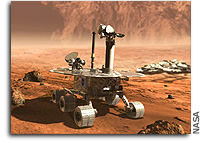DuPont Electronic Materials Keep Mars Rovers Going One Year Late

High-Tech Materials Connect the `Brains’ of Spirit & Opportunity to Their Parts
One year to the month after Spirit and Opportunity landed on Mars, the Rovers are still roaming the planet, sending back crystal-clear images of the Martian surface. Their durable parts help keep them going, enabled by DuPont science.
The Mars Exploration Rovers – Spirit and Opportunity – both contain critical parts made from materials developed by DuPont Electronic & Communication Technologies. Since the birth of manned space flight more than four decades ago, DuPont has been along for the ride with products essential for lighter weight, reduced volume, durability and environmental resistance.
Consumers will find the same DuPont technologies enabling cell phones, plasma display panels, personal digital assistants (PDAs), video camcorders, laptop computers and digital cameras, among others. DuPont electronic materials make these products smaller and more durable, while allowing them to do more, faster and better.
These high-tech materials provide the same solutions so that today’s rovers have more space for additional scientific payload. The Mars rovers include almost 70 yards each of flexible circuits made of thin DuPont(TM) Pyralux® laminates and composites. By replacing bulky round wires and cables, these materials can provide a volume savings of between 60 percent and 70 percent. Stacked, they would total less than 1.5 inches. Pyralux® flexible circuits connect the “brain” of the rovers to their parts – the robotic arm, cameras, high gain antenna, wheels and sensors.
Pressure-sensitive tape made of DuPont(TM) Kapton® polyimide film is used throughout the rovers to control vibration. Pyralux® flexible cables secured with Kapton® tape offer durable, lightweight environmental resistance for the temperatures on Mars, ranging from minus 120 degrees Centigrade (minus 184 degrees Fahrenheit) to 22 degrees C (72 degrees F).
Hundreds of Kapton® strip heaters are used throughout the rovers for thermal control, ensuring critical warmth needed to maintain operations in the extremely cold Martian atmosphere. They are wrapped around each of the motors on the robotic arm to keep the motors and gearboxes running at optimum temperature and efficiency. Traditional copper wires and cables have large conductors that can easily allow heat to escape from the rover electronics module, threatening a shortened mission life. Kapton® strip heaters significantly reduce that risk and allow the rovers to use smaller solar panels and batteries.
The cameras beaming clear, high resolution signals back to Earth can do so in part because the Pyralux® flexible circuits were made using DuPont(TM) Riston® dry film photoresists and ImageMaster(TM) phototooling films that provide reliable fine-line circuit images, ensuring consistent quality signals and performance.
“DuPont materials have enabled manned and unmanned missions into space for almost half a century,” said Craig G. Naylor, group vice president, DuPont Electronic & Communication Technologies. “That’s the same trend you can see and feel in everyday products like lighter, thinner cell phones, yet these smaller, more advanced electronics are much more powerful.”
DuPont electronic materials provide key benefits such as volume and weight savings, in addition to the bend and twist flexibility.
Kapton® film works with layers of DuPont(TM) Teflon® fluoropolymer resin and Pyralux® flexible cables to provide power from the Rover Electronics Module to the hardware components in the rovers. The flexible joints of the robotic arm, which must withstand repeated bending in extreme environments, use Kapton® and Pyralux®.
Metallized Kapton® is used in thermal shielding for heat-sensitive components. The airbags, so critical to the rovers’ successful landings, are threaded and reinforced with DuPont(TM) Kevlar® brand fiber.
In addition to the rovers, satellites orbiting Earth today provide clear communications because of thin, lightweight and durable Pyralux® flexible circuits.
Other DuPont inventions have contributed to space exploration. On Apollo missions to the moon, 20 of the 21 layers in each space suit were made with DuPont materials, including DuPont(TM) Mylar® polyester film, neoprene and Kapton®. Today’s suits include fewer layers but many of the same products, in addition to Nomex® and Kevlar® branded fibers. Kevlar® also was used on the Galileo probe to Jupiter, which included a parachute made of Kevlar®, and at the International Space Station, where a blanket made of Kevlar® was used to wrap its inner walls to protect from micrometeorites. In addition, the Space Station’s wings used Kapton® to absorb UV rays.
DuPont Electronic & Communication Technologies is a leading supplier of electronic materials, fluoropolymers, fluorochemicals and imaging technologies.
DuPont is a science company. Founded in 1802, DuPont puts science to work by creating sustainable solutions essential to a better, safer, healthier life for people everywhere. Operating in more than 70 countries, DuPont offers a wide range of innovative products and services for markets including agriculture, nutrition, electronics, communications, safety and protection, home and construction, transportation and apparel.
The DuPont Oval, DuPont(TM), The miracles of science(TM), and Pyralux®, Kapton®, Riston®, ImageMaster(TM), Teflon®, Kevlar®, Nomex® and Mylar® are registered trademarks or trademarks of DuPont or its affiliates.
DuPont(TM) Pyralux® brand flexible laminates are used to connect the “brains” of the rovers to their parts (photos-Dynamic Design International), as they do in more familiar applications, like the display driver(1) and hinge circuits(2) in a flip phone(3) (cell phone photo-DuPont).









